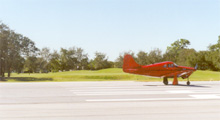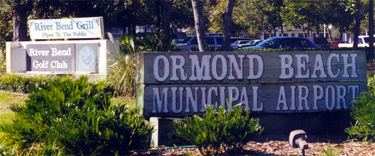William W. Amick
ASGCA Golf Course Architect
|
|
|
|
|
|
|
Building an Airport Golf Course |
|
|
|
Have you ever wished while traveling that you could just grab your golf clubs from the baggage carousel and be on the first tee within the hour? This is becoming a reality for more and more golfers because a growing number of airports are now including golf course projects on their property. Why? Because an airport that chooses to build a course can enjoy direct economic benefits as well as significant marketing advantages over their competition. Examples
of noted airports that have recognized these benefits and built golf courses
include the Hyatt Bear Creek Hotel & Resort. It has 36 holes at the Dallas/Fort Worth International
Airport. Its Website can be seen at
www.hyatt.com.
A popular airport short course is the Westchester Golf Course at the Los
Angeles International Airport (LAX).
Pease International Tradeport in Portsmouth, New Hampshire, also has a
golf course in their airport complex. It
is showcased at www.peasedev.org. So,
what are the factors that allow a public golf course to become such a successful
addition to an airport? First, most
airports have more than enough acres of unused land that is appropriate for
building a golf course. Once this
vacant land is improved by building a course, it can start producing a profit.
And with a long-term lease between the airport and the golf course’s
operator, these types of arrangements can last for decades. However,
the greatest economic advantage of building an airport golf course can in fact
be indirect. This is because a golf
course can provide a real marketing edge over the competition.
Given the option of leasing land near a course or not, many corporate
tenants will choose this amenity for themselves and to benefit their employees.
This means having an airport course can translate to increased land
leasing revenues for the airport’s bottom line – especially along fairway
frontage. Many
offices, “clean” manufacturers, high-tech companies, warehouses,
distribution centers and other businesses also enjoy the feelings of a “nice
neighborhood” created by a golf course. This
kind of environment creates a beautiful and appealing landscape as well as easy
access to recreational and social opportunities for area employees.
Golfers working around the airport especially like the fact they can play
their favorite sport in their own backyard.
As a revenue source for the golf club, the airport’s employees and
those of corporate tenants form an immediate pool of potential golfing
customers. These numbers will of
course increase as the airport facility continues expanding.
A
golf course can also provide strong incentives for hotels, motels and conference
centers to lease land and build at an airport location.
This is because having a course on site can influence golfing visitors to
lengthen their stays while at conventions, vacations or other events. In
my four decades of professional golf course design I have been involved in
several airport golf course projects. For
the Savannah International Airport I prepared the original golf course routing
plan. I also assisted with
providing information for the airport’s application in obtaining the required
wetlands permit from the Army Corps of Engineers. The Website of a motel at the airport next to this golf
course can be found at www.fairfieldinn.com. You
can access the Website for a course I designed at a naval air station by
clicking on the following link, www.mwr-pcola.navy.mil.
I’ve also designed an additional nine holes at an air force base and
planned the major remodeling of the greens at a separate air force base course. Near
my home in Daytona Beach, Florida, I designed an 18 hole layout for the Spruce
Creek Fly-In Community. This
successful development features many homes that are situated between private
hangers on the taxiway side and golf fairways on the other. More can be learned about this community at www.cc-properties.com. Drawing
on my experience with these kinds of projects, let me now share with you how the
process of adding a golf course to an airport facility typically proceeds.
During the initial discussions and touring the site, I advise if an
airport has enough suitable land for a successful course.
After my visit, I explain the major preparatory steps, making a
preliminary cost estimate and provide the planning schedule for the golf course. My
firm in some cases also prepares a preliminary routing plan showing the proposed
course on a color drawing for display, promotional and approval purposes.
If other facilities will be surrounding or adjoining the course, the
routing of the golf holes will be coordinated with their planning as well. Sometimes
an economic feasibility or market demand study is valuable for deciding if there
will be enough golfers to support golf course and what kind of revenue should be
expected from it. If needed, I am
able to recommend consultants which prepare these studies.
Also, I can work with local engineers or other professional firms
specializing in airport planning for obtaining any necessary zoning, permits or
approvals for building the course. Following
the permitting process, I prepare detailed drawings and technical information
for proper construction of the course. If
requested, I can even furnish a list of golf course operators (course/club
management companies) who might lease the site, provide their own financing and
operate the course under a long-term arrangement.
If you are curious about any of these essential steps regarding adding an
airport course, simply contact me and I will be glad to provide you with
additional information. Interestingly,
many of the advantages in building an airport golf course also makes a project
like this very appealing to potential golf course operators and management
firms. Most importantly, the course
operator doesn’t have to make the large initial investment to buy land.
An additional benefit to the management company is that the lease
payments normally start only after the golf course is open and generating
revenue from golfers. Busy airports
typically are more likely to be profitable locations because they have a large
local base of potential golfers and easy highway access.
These advantages, coupled with the fact that many air travelers and
pilots already enjoy playing golf, make airports very lucrative locations for
projects like this. In
the past, airport courses have been built by many types of entities.
These include another department of the airport’s municipality, the
parks and recreation department of a local government or even by the airport
itself. The following is a partial
list of airports that are reported to have already recognized the advantages
afforded by an airport golf course on or adjacent to their land: ·
Dane
County Regional Airport, Madison, Wisconsin ·
Port
Columbus International Airport in Ohio ·
Craig
Field of the Jacksonville Port Authority in Florida ·
Salt Lake
City International Airport in Utah ·
Santa
Barbara Municipal Airport in California with a golf course for more than 25
years ·
Saint
Petersburg-Clearwater International Airport in Florida has enjoyed a profitable
course for almost half a century ·
Clearwater
Air Park also in Clearwater, Florida has a smaller golf course ·
Hayward
Executive Airport in California ·
Prescott
Municipal Airport in Arizona has 36 holes ·
Pompano
Beach Airpark in Florida also has a 36-hole golf course ·
Austin-Bergstrom
International Airport in Texas ·
Spirit of
Saint Louis Airport in Chesterfield, Missouri ·
DuPage
County Airport in Illinois ·
Fresno
Air Terminal in California ·
Rock
County Airport in Janesville, Wisconsin ·
Petahuma
Municipal Airport in California ·
West Palm
Beach International Airport in Florida ·
Michigana
Regional Transportation Center in South Bend, Indiana ·
Zephyrhills
Airport in Florida ·
Sarasota-Bradenton
International Airport in Florida ·
John
Wayne Airport in Costa Mesa, California has nine holes of an 18-hole course on
airport land ·
El Paso
International Airport in Texas ·
Valkaria
Airport in Brevard County, Florida ·
Huntsville
International Airport in Alabama ·
Reno/Tahoe
International Airport in Nevada ·
Minneapolis-Saint
Paul International Airport in Minnesota ·
Formerly
there was an 18-hole course at the Oakland International Airport in California.
The Port of Oakland used it as a site for depositing material dredged
from the harbor. A new 18 holes is
to be constructed on top of that material. ·
Cheyenne
Airport in Wyoming ·
Sebastian
Municipal Airport in Florida ·
Venice
Municipal Airport in Florida ·
Ormond
Beach Municipal Airport in Florida ·
Las
Vegas/McCarran International Airport in Nevada has recently signed a 99-year
lease for a new 36-hole golf course ·
Loring
International Airport in Limestone, Maine ·
Southern
California Logistics Airport in Victorville ·
Williams
Gateway Airport in Mesa, Arizona ·
Nanaimo
Airport in Cassidy, British Columbia ·
Oshawa
Municipal Airport in Ontario ·
Abu Dhabi
International Airport in the Untied Arab Emirates ·
Hobart
Airport in Australia ·
Nadi
Airport in Fiji ·
Auckland
Airport in New Zealand Most airports have a forward-looking board and
administrative staff who quickly understand the advantages of building a golf
course on their land. In virtually
all cases, the airport staff and management work closely with the golf course
operator to create a friendly and cooperative business relationship for everyone
involved in the project. As one airport
director glowingly said of his course, “We have an 18-hole golf course with
its beautiful clubhouse. In winter
months part of the course is used for skiing, snowboarding and tubing.
We also have a 50-acre campground. These
are why we say our airport is acres and acres of fun.” So,
please call me or click on my email link below if you would like to begin
learning more about the possibilities of including a golf course at your
airport. There is no cost or
obligation for our initial discussion. I
will be glad to discuss with you about how a new course could start adding
additional sources of revenue to your organization, enticing area companies to
sign leases with you and begin encouraging travelers and local golfers to choose
your airport facility over your competition.
And soon there may be some objects flying around your airport that don’t need clearance from the tower!
|
|
|
| Professional Golf Course Designer - Bill Amick |
| P.O.
Box 1984 Daytona Beach, FL 32115 Telephone (386) 767-1449 |
| amick@iag.net |


